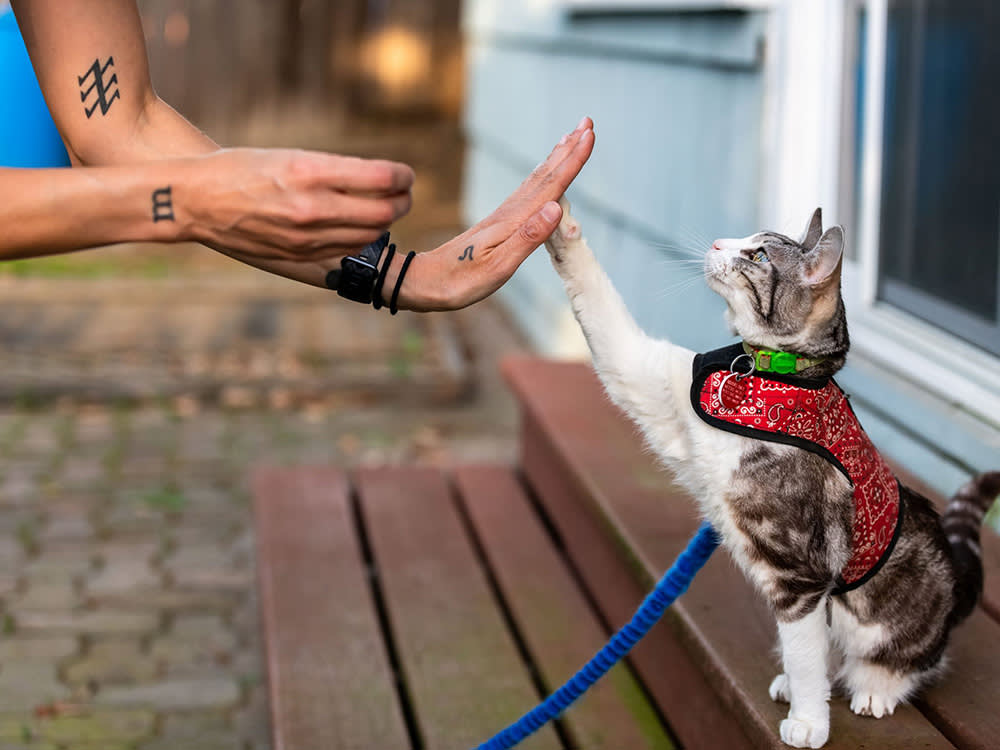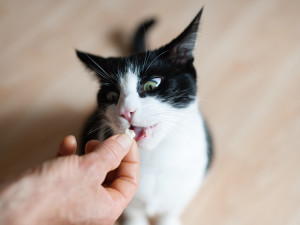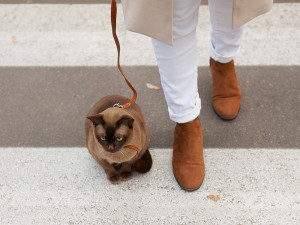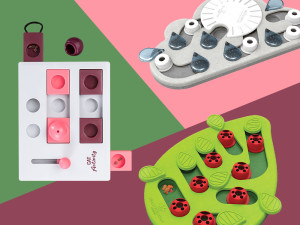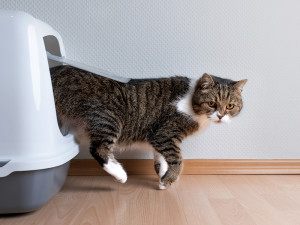A Step by Step Guide on How to Clicker Train Your Cat
This popular training technique isn’t just for dogs. Here’s how you can use it for your cat.
Cats get a bad rap when it comes to training, and it regularly surprises people to hear that cats can be trained, but of course they can. If we can train llamas, fish, pigeons, horses, and bees, then surely cat training makes all the sense in the world. Not only can cats be trained, but they take to it well, it improves their quality of life, it strengthens our relationship with them, and it’s tons of fun for them and for us.
My favorite way to train cats is with a clicker. Clicker training cats is becoming increasingly popular. Even though you might think clicker training is more for dogs, it’s actually not. This style of training didn’t even originate with dogs. Long before dogs were trained this way, marine mammal trainers — especially those who worked with dolphins — were using whistles like we use the clickers now. Clicker training has since been used with a huge variety of species, including cats.
What is clicker training for cats?
The clicker is a small device a little bigger than a large thumb that makes a “click” sound when you press it, and that sound tells an animal, “The behavior you just did — that right there! — is the behavior I will pay you for with delicious food (or something else of really high value to you).” The clicker “marks” the behavior we want to see more of, and because it is followed by a treat, the behavior is more likely to happen again. In other words, clicker training is a type of positive reinforcement training.
What equipment do I need to start clicker training my cat?
Luckily, you need very few items to start clicker training your cat. In fact, there are just two items in a cat clicker training kit — a clicker and treats. Clickers are available at pet stores and online for just a few dollars. Treats work best if they are of really high value to your cat and they are both soft and small for easy, quick eating.
How much do you spend on your pet per year?
How does clicker training work?
Whether you use a whistle, a clicker, or some other sound to mark a behavior, the marker is called a “bridging” stimulus because it “bridges” the time between the behavior and the delivery of the treat. (With the last name of London, it’s no surprise it’s my favorite clicker-training term!)
Marine mammal trainer and dog trainer Karen Pryor is synonymous with clicker training; it was her seminars years ago that brought marker training with a clicker to the field of dog training. Having used marker training for years with dolphins and porpoises, she shared the skills and ideas from her animal training work with the dog world, and it caught on quickly. More recently, it has caught on with cat training, bringing the same advantages of the method to many felines and their parents. Cat clicker training is marker training with cats, and that marker is most frequently a click.
Clicker training is effective with cats because they enjoy it, and they learn well using this method. Pryor writes in the introductory pages of her book Clicker Training for Catsopens in new tab: “Even the least little bit of time spent in clicker interactions, perhaps three or four minutes a day, will make changes in your cat...The clicker game may also make your cat more interested in you...not just because you hand out treats, but because you become an interesting challenge...[they’re] training you to click, and that’s very satisfying to cats.”
How do I get started with clicker training my cat?
Clicker training cats is so fun, so powerful, and so effective that most people who train cats this way express their enthusiasm about the technique with the zeal of the newly converted — no matter how long they have been training this way. There are enough nuances and details to keep experts meeting at conferences and discussing their work endlessly online, but the basics are, well, basic, and anyone can dive in and have success right away. Clicker training for kittens is a great way to build a great relationship, so keep in mind that clicker training your cat is possible for young and old kittens alike.
To get started, you need a clicker and your cat (Captain Obvious here!), and a bunch of tasty treats. The treats should be fresh food that your cat adores and soft enough to be eaten quickly. (Think tuna or roast chicken, not kibble.) Use small pieces so your cat is not full after three treats. It may help to train them before they eat so they are hungry.
The first step is called “charging the clicker,” and it means that you are teaching your cat that the click means a treat. At the same time, click and give the cat a treat — either toss it, present it on a plate, or hand it to your cat directly. My preference is to toss the treat a foot or two away just to add some activity into the training. The cat does not have to do anything to earn the click and treat, and you do not need to talk to the cat or touch them or try to influence them in any way. After a handful of simultaneous clicks, separate them in time by clicking and then tossing the treat right away — within a second. If your cat doesn’t respond to the clicker by acting like they anticipate the treat, keep working on charging the clicker.
Once your cat knows the click means a treat, the next step is to teach your cat they have the power to make you click and treat by doing certain behaviors. The key at this stage is to be very generous with your clicks and treats so your cat has a positive experience and does not get frustrated.
The first behavior I like to teach a cat when I am clicker training is to target. “Targeting” is touching an object you present to them, usually with their nose. The object can be a spatula, a chopstick, a wooden spoon, or any long object without a sharp end. Once a cat knows how to target, you can guide them to where you want them to be without stressing them out by picking them up or physically moving them. Targeting makes it easier to lead your cat into a carrier, onto a bed, up to a cat tree, into another room, or anywhere else you want them to be. To begin, put the target near your cat, and if they touch it with their nose, click, and give them a treat. Timing is critical with clicker training, so focus on clicking the instant your cat touches the target. While they eat, put the target out of sight behind your back, bringing it back out when they are done with the treat. Make it as likely as possible that your cat touches the target by putting it very close to their face. Some cats will approach from a few inches away or more, but others need it so close it’s hard for them not to touch it. Over time, you can present the target at a greater distance.
How long should each clicker training session be?
One of the great secrets of training that professionals know but amateurs often don’t is that training sessions should be short. Without specifying what “short” means, most people will train for too long at once which leaves their animals tired, frustrated, and not having such a good time. That is not the way to make training fun or effective. It is best to make training session so short that your cat doesn’t want it to end yet.
Keep them wanting more and you will have a better trained, happier cat, and those goals will happen faster. So, what do professional trainers mean when they tell you to keep training sessions short? One to five minutes is a good range, and even sessions of less than a minute are common. Try to stop while your cat is still interested because leaving them wanting more is a great way to keep them motivated and eager to train in the next session.
What are the benefits of clicker training cats?
There are many benefits of clicker training. Some of them are small, like being able to show off to your friends your cat’s newest or most charming trick, but others are profound. Clicker training enhances your relationship with your cat, improves your communication with each other, and offers increased quality of life for both of you. Those are some big benefits for an activity that is fun and practical.
Acquisition of skills. Once a cat understands the game of clicker training (that’s what it seems like to them — a game), you can teach them all kinds of useful, easy, fun behaviors. A few options include twirling, going to a station which can be a bed or a perch, to come when called, to retrieve, to sit, to jump on the counter, to jump off the counter, to touch a target, and so much more. The behaviors you can teach a cat are only limited by your imagination and their comfort zone.
Improved communication. Clicker training your cat offers you and your cat better communication, the opportunity to catch your cat doing something right, and enrichment. It helps avoid unwanted physical contact and misunderstandings. It’s a way to build trust, have fun together, and to give your cat a sense of agency over their life because they are learning what to do to make you click and give them treats.
Better quality of life. There is great joy and enrichment and a better life for cats who are able to earn delicious treats by performing certain behaviors. It’s important for cats to engage their brain, have their own actions influence what happens to them, and generally to have something to do beyond eat, groom, and sleep. Even a few two-minute sessions of clicker training can make an enormous difference in a cat’s quality of life.
A better relationship. Clicker training is a fun activity you and your cat can do together and whenever individuals share positive experiences, that builds the relationship. Add in the improved communication that leads to better understanding, and more trust as well as the enrichment of your lives, and clicker training puts you on the fast track to the wonderful relationship we all seek with our cats.
When it comes to the value of clicker training, nobody says it better than Karen Pryor herself, who wrote this about clicker training: “It begins with reinforcement. It becomes communication and it leads to communion — and that’s a good name for ‘love.’”
FAQs (People Also Ask):
Is clicker training effective for cats?
Clicker training cats is very effective for teaching your cat skills and tricks, and also for enhancing your relationship with each other.
What behaviors can I teach my cat with clicker training?
You can teach your cat any skill with clicker training, though most people use it to teach tricks, to teach a cat to go to their place, and to touch a target stick.
